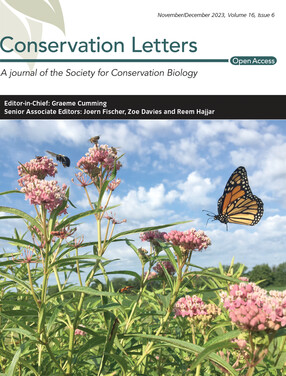Longevity Collapse in Dolphins: A Growing Conservation Concern in the Bay of Biscay
IF 7.7
1区 环境科学与生态学
Q1 BIODIVERSITY CONSERVATION
引用次数: 0
Abstract
Marine megafauna populations face global decline from human impacts, making early detection of demographic tipping points essential for effective conservation. Traditional viability analyses rely on Capture‐Mark‐Recapture data, logistically impractical for highly mobile pelagic cetaceans. Stranding data provide an alternative to conventional monitoring. This study presents the first evidence of declining viability in the most abundant cetacean of the Northeast Atlantic Ocean, the common dolphin (海豚寿命的缩短:比斯开湾日益增长的保护问题
由于人类的影响,海洋巨型动物的数量正面临全球范围内的下降,因此及早发现人口转折点对有效保护至关重要。传统的生存能力分析依赖于捕获-标记-再捕获数据,对于高流动性的远洋鲸类来说,这在逻辑上是不切实际的。搁浅数据为常规监测提供了另一种选择。这项研究首次提出了东北大西洋最丰富的鲸类动物——比斯开湾的普通海豚(Delphinus delphis)生存能力下降的证据。使用分层随机抽样的新型横截面框架,我们分析了1997年至2019年间收集的759个标本的死亡年龄数据。女性寿命从24岁急剧下降到17岁,与人口增长率下降2.4%相对应。这种人口数量的下降凸显了比斯开湾的人口数量下降,尽管丰度估计稳定。我们的研究结果表明,搁浅数据可以为广泛的鲸类物种提供急性人口统计信号,为主动保护管理提供关键的预警指标。
本文章由计算机程序翻译,如有差异,请以英文原文为准。
求助全文
约1分钟内获得全文
求助全文
来源期刊

Conservation Letters
BIODIVERSITY CONSERVATION-
CiteScore
13.50
自引率
2.40%
发文量
70
审稿时长
>12 weeks
期刊介绍:
Conservation Letters is a reputable scientific journal that is devoted to the publication of both empirical and theoretical research that has important implications for the conservation of biological diversity. The journal warmly invites submissions from various disciplines within the biological and social sciences, with a particular interest in interdisciplinary work. The primary aim is to advance both pragmatic conservation objectives and scientific knowledge. Manuscripts are subject to a rapid communication schedule, therefore they should address current and relevant topics. Research articles should effectively communicate the significance of their findings in relation to conservation policy and practice.
 求助内容:
求助内容: 应助结果提醒方式:
应助结果提醒方式:


